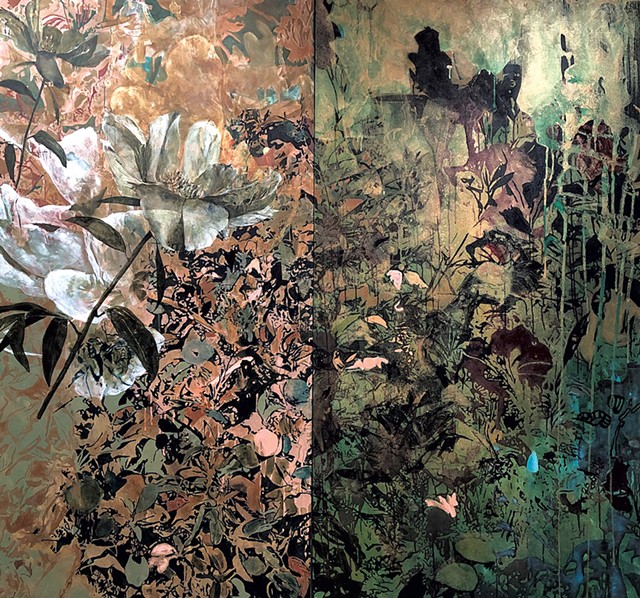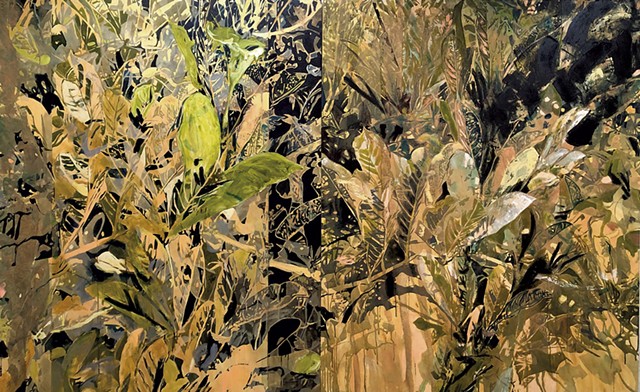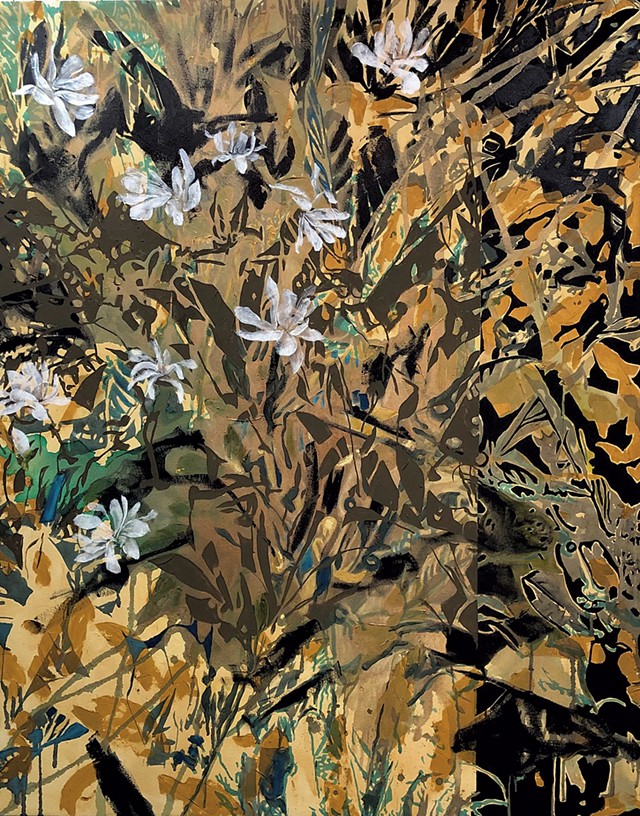
"encounter"
With Her Exhibit 'Poetic Ecologies,' Painter Cameron Davis Explores Radical Aliveness
By Pamela Polston
Published March 1, 2023 at 10:00 a.m. for www.sevendayssvt.com
Cameron Davis' paintings simultaneously convey vastness and intimacy. Her works are loosely tethered to botany, yet the recognizable shapes of petals and leaves could be seen as spirit guides to a less understood but deeply immersive realm. Call it the web of life. Or call it, as Davis does, "poetic ecologies."
That's the title of her entrancing solo exhibition at the Vermont Supreme Court Gallery in Montpelier; the phrase, which Davis borrowed from German biologist and writer Andreas Weber, hints at her existential engagement with nature. Her goal is not simply to observe and replicate earthly elements on canvas; rather, Davis investigates what it means to be in an empathic relationship with the Earth.
"My paintings are fundamentally an act of sense making," her artist statement begins. "I have been circling experiences of presence in nature — including questions of what is nature — within the formal language of painting for 40 years."
"At a perceptual level, connectivity is a form of activism." Cameron Davis
Davis recently retired after teaching for 34 years in the University of Vermont art department and is currently on sabbatical. And she's putting in time at the easel: Many of the paintings in her exhibit are quite new.
Most of the 17 acrylic works in the courthouse gallery are large — particularly several diptychs. "Encounter," for example, is 72 by 60 inches. Several ghostly magnolia blossoms dominate the left panel; the right contains a thicket of murkier plant shapes and colors. Gestural dabs of bright turquoise and sherbet orange, perhaps liberated petals, seem to leap from the foreground.
In the 80-by-60-inch "Entanglements With Spare Intensities," vivid turquoise blossoms seem to dance atop a bramble of other plant patterns, while in the center of the diptych, areas of cavernous black pull the eye deeper.
Davis' skilled application of contrasting hues and translucency gives her canvases remarkable dimensionality. Even the denser compositions have an ethereal inner glow, beckoning like a secret.
To create literal layers on the canvas, Davis uses a mix of other techniques, including tracing projections, laying down physical plants that leave impressions when removed, and pouring and manipulating paint. Some of the paintings subtly shimmer, as if sprinkled with fairy dust. Alas, the source is less chimerical: "It's watered-down gold paint," the artist said.

"Magnolia Memorial I"
Davis compared the elements in her paintings to "different kinds of languages — spontaneous, intuitive, referential, photographic, impressionistic," she said. "I'm really interested in what happens mashing up these different vocabularies. How do you make those work? That's where the newness happens."
Her artistic process creates multiple spaces — perhaps multiple realities — within a single painting. The visual experience is both unsettling and enticing, like coming upon a portal to a parallel universe. "I like that space shifting, which for me also corresponds to time shifts," Davis said. "I like that fracture, or disjunction of time and space."
In a wide-ranging phone conversation, Davis shared ideas about coexistence with the Earth, the practice of awe and why painting is like life.
There's a lot to unpack in your artist statement. You write that you've been "circling experiences of presence in nature..." Do you mean human presence?
I'm exploring the subjective nature of nature, and that includes humans, but also that there is presence in liveness.
What is your formal language in painting?
What I'm doing is using line and color and mark, surface, space. The paintings have imagery, or subject matter, that might refer to plant patterns, but I also think the process itself reveals how nature works. Multiple layers of communication happen.
The [painting] process is improvisational, so the references to the patterns almost could be an equivalent to laying down a melodic line and then responding to it. Contrast, saturation of color, detail, three-dimensionality — they have a kind of pace. What you notice more, or less, that's where it starts to feel musical. Those coherent moments feel emergent.
Working musically, you lay down a track. But the tracks aren't separate; they're talking to each other. Accidents happen, relationships that you hadn't noticed. It's a corollary to how life works, how evolution works.

"Magnolia Memorial"
Continue reading interview here
The exhibition is up through March 31, 2023 at the Vermont Supreme Court Gallery, more information here